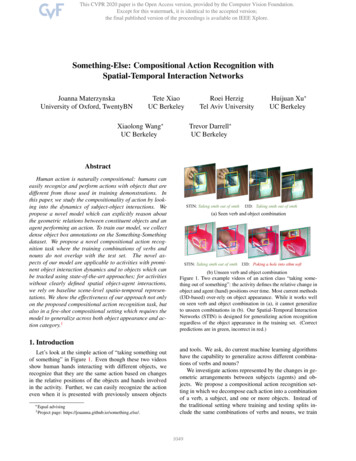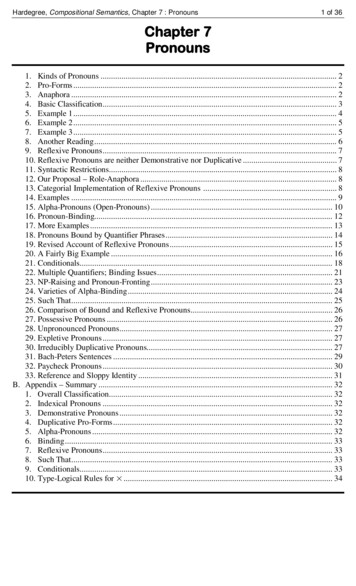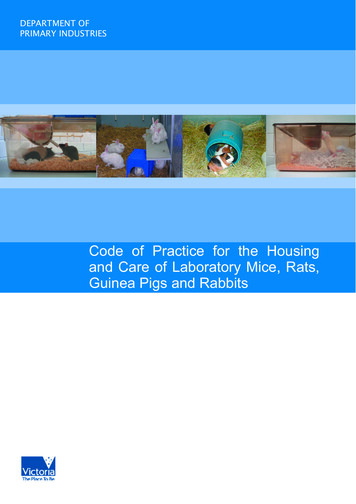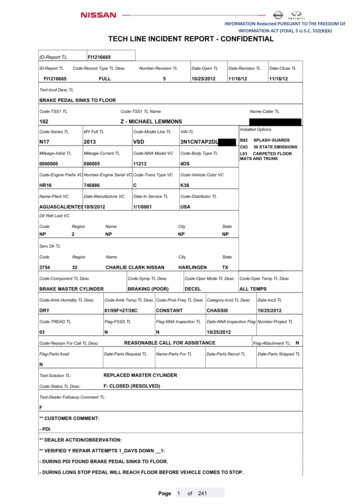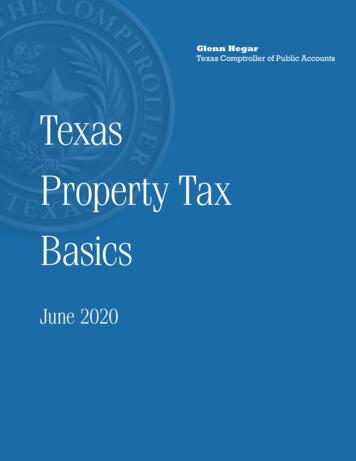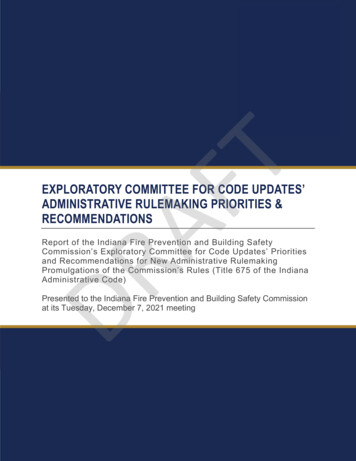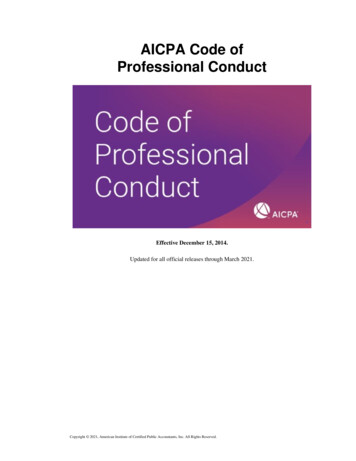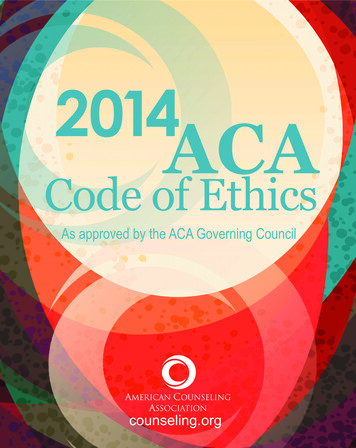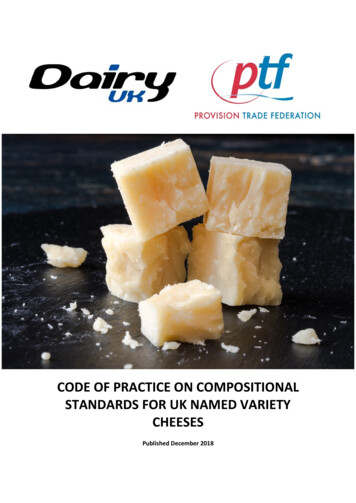
Transcription
CODE OF PRACTICE ON COMPOSITIONALSTANDARDS FOR UK NAMED VARIETYCHEESESPublished December 2018
Table of ContentsIntroduction . 1Definitions . 2Composition . 2Standard Milk Fat Levels . 2Modified Milk Fat Levels . 2Cheese Compositions and Characteristics by Variety . 4Cheddar Compositional Standards . 4Double Gloucester Compositional Standards . 4Derby Compositional Standards . 5Cheshire Compositional Standards . 5Caerphilly Compositional Standards . 6Lancashire Compositional Standards . 6Wensleydale Compositional Standards . 7Leicester Compositional Standards. 7Permitted Additives . 7Declaration of Ingredients . 7Annex 1 - Relevant provisions in the Food Labelling Regulations 1996 . 8Annex 2 - Relevant legislation . 92
IntroductionThe dairy industry recognises the need for there to be a common understanding among consumers,manufacturers and retailers as to the nature of certain named variety cheeses, taking into accountthat, when the Food Labelling Regulations 1996 are revoked, there will no longer be specificlegislation relating to product composition and labelling.As a result, this Code has been drawn up Dairy UK and the Provision Trade Federation and will comeinto operation from the date the relevant provisions within the Food Labelling Regulations 1996 arerevoked; i.e. on the 13th of December 2018.The main provisions of this Code are to retain the compositional standards of some named varietycheeses set out in the Food Labelling Regulations 1996 and for the names of these cheeses tobecome customary, as defined in the EU Food Information to Consumers Regulation (EU1169/2011).This Code permits the variety name to be used for cheeses which have a modified composition solong as the name is qualified by other words describing the modification.The provisions within this Code also apply to composite products as defined in Commission Decision2007/275/EC, e.g. Wensleydale with apricots. These compositional standards only apply to thecheese component and do not take into account the composition of other ingredients.The provisions of this Code do not in any way alter the law.1
Definitions“Cheese” means the fresh or matured product intended for sale for human consumption, which isobtained by the combining, by coagulation or by any technique involving coagulation, of any of thefollowing substances, namely milk, cream, skimmed milk, partly skimmed milk, concentratedskimmed milk, reconstituted dried milk, butter milk, materials obtained from milk, other ingredientsnecessary for the manufacture of cheese provided that those are not used for replacing, in whole orin part, any milk constituent, with or without partially draining the whey resulting from coagulation.The term “cheese” is protected by EU legislation - Regulation (EU) 1308/2013 - and can only be usedfor products derived exclusively from milk, on the understanding that substances necessary for theirmanufacture may be added provided that those substances are not used for the purpose ofreplacing, in whole or in part, any milk constituent.All the cheeses described in this Code can be manufactured with milk from cows, goats or sheep.CompositionStandard Milk Fat LevelsThe name specified in the individual cheese variety table shall not be used in the labelling oradvertising of any cheese as the name of the cheese, unless:a) the amount of water in the cheese expressed as a percentage of the total weight of thecheese does not exceed the percentage stated in the Maximum Moisture column expressedin the individual cheese variety table;b) the amount of milk fat in the cheese expressed as a percentage of the total weight of thecheese is in line with the parameters stated in the Minimum Fat and Maximum Fat columnsexpressed in the individual cheese variety table;c) the amount of milk fat in the cheese expressed as a percentage of Fat in Dry Matter (FDM),the dry matter of the cheese is in line with the parameters stated in the Minimum FDM andMaximum FDM columns expressed in the individual cheese variety table;d) the organoleptic properties of the cheese fall within the general characteristics of the cheesevariety as detailed in the Characteristics section of the individual cheese variety table.These tables have been developed using values included in former provisions contained in the FoodLabelling Regulations 1996 (Annex 1). As such, the relevant cheese names listed in these provisions(when unqualified) are to be treated as customary names.Modified Milk Fat LevelsFor varieties where the milk fat content has been modified to be lower than that found in thestandard cheese, the descriptors “reduced fat” and “half fat” along with the variety name can beutilised for labelling purposes as long as the moisture, milk fat and fat in dry matter meet therelevant criteria contained within the individual cheese variety table for the level of fat modificationrequired (as detailed in a to c above). According to the Nutrition and Health Claims Regulation (EC1924/2006), a claim stating that a food has “reduced fat” may only be made where the reduction incontent is at least 30% compared to a similar product which is representative of the category.Alternative descriptors to reduced fat and half fat with the variety name are also permitted.2
If use is made of modified milk fat levels, the resultant cheese should exhibit as far as possiblethe characteristics traditionally associated with the named cheese in terms of flavour profile andtexture as detailed in the Characteristics section of the individual cheese variety table.Cheeses with fat contents lower than the half fat values are not permitted to use the variety nameas with current technology their organoleptic qualities are not considered to be sufficiently close tothose of the named variety.3
Cheese Compositions and Characteristics by VarietyAveragefat (%)Cheddar Compositional StandardsMinimum MaximumMaximumfat (%)fat (%)moisture (%)3917.5Notapplicable24.4Minimum Fatin Dry Matter(FDM) .929.0Reduced fat(@30%)Half fat(@50%)22.115.8MaximumFDM (%)Cheddar CharacteristicsColour: White to yellow.Texture: Generally waxy body which breaks down smoothly when kneaded between fingers. Somematured recipes may be flintier and may have small crystals of calcium lactate throughout or smallcrystals of tyrosine within the interior.Flavour: Clean, creamy and mellow at a young age with a more pronounced flavour at longermaturities. There are typically 4 dominant flavour profiles for more mature variants: farmy/earthy,meaty/savoury, sharp/tangy and sweet/nutty.May be manufactured and sold with or without rind which may be coated.StandardAveragefat (%)35.0Reduced fat(@30%)Half fat(@50%)NotavailableNotavailableDouble Gloucester Compositional StandardsMinimum MaximumMaximumMinimum FDMfat (%)fat (%)moisture 9MaximumFDM (%)Notapplicable4738Double Gloucester CharacteristicsColour: Pale straw through to pale tangerine and orange.Texture: A close firm texture, some recipes may be flakier. Typically less firm than Cheddar.Flavour: A full clean and mellow flavour with a nutty character and slight tang with morepronounced flavours at longer maturities.May be manufactured and sold with or without rind which may be coated.4
Averagefat (%)StandardReduced fat(@30%)Half fat(@50%)Derby Compositional StandardsMinimum MaximumMaximumfat (%)fat (%)moisture (%)4217.0Notapplicable23.7Minimum Fatin Dry Matter(FDM) vailableNotavailableMaximumFDM (%)Derby CharacteristicsColour: Light yellow to pale honey.Texture: A close firm texture, can be slightly flaky. Typically less firm than Cheddar.Flavour: Clean, mild and buttery when young with a pronounced tang at full maturity.May be manufactured and sold with or without rind which may be coated.Averagefat (%)StandardReduced fat(@30%)Half fat(@50%)31.8Notavailable15.3Cheshire Compositional StandardsMinimumMaximumMaximumMinimum Fat infat (%)fat (%)moisture (%)Dry Matter(FDM) ximumFDM (%)Notapplicable4334Cheshire CharacteristicsColour: White to pale yellow.Texture: A firm and crumbly texture. Crumblier than Cheddar, becoming firmer as it matures.Flavour: Milky and slightly tangy when young, moving to rich, mellow and more rounded uponmaturation.May be manufactured and sold with or without rind which may be coated.5
Averagefat (%)StandardReduced fat(@30%)Half fat(@50%)31.3NotavailableNotavailableCaerphilly Compositional StandardsMinimum MaximumMaximumMinimum Fatfat (%)fat (%)moisture (%) in Dry Matter(FDM) mumFDM (%)Notapplicable452736Caerphilly CharacteristicsColour: White.Texture: Semi-soft and flaky/crumbly.Flavour: Clean, mild and slightly salty becoming more creamy, complex and rounded onmaturation.May be manufactured and sold with or without rind which may be coated.Averagefat (%)StandardReduced fat(@30%)Half fat(@50%)31.722NotavailableLancashire Compositional StandardsMinimum MaximumMaximumMinimum Fatfat (%)fat (%)moisture (%) in Dry Matter(FDM) ximumFDM (%)Notapplicable4637Lancashire CharacteristicsColour: Crumbly Lancashire: bright white; Creamy and Tasty Lancashire: slightly yellow.Texture: Crumbly Lancashire is crumbly, whilst Creamy and Tasty Lancashire has a semi-softtexture.Flavour: Crumbly Lancashire has a clean, mild and slightly sharp flavour with a milky background;Creamy Lancashire has a slightly mellow flavour and creamy background with flavours becomingtangier as it ages to become Tasty Lancashire.May be manufactured and sold with or without rind which may be coated.6
Averagefat (%)StandardReduced fat(@30%)Half fat(@50%)31.8NotavailableNotavailableWensleydale Compositional StandardsMinimum MaximumMaximumMinimum Fatfat (%)fat (%)moisture (%) in Dry Matter(FDM) mumFDM (%)Notapplicable4536Wensleydale CharacteristicsColour: White.Texture: Supple, crumbly and moist.Flavour: Clean, mild and fresh with honeyed aftertaste and slight acidity when young. As it ages,the cheese develops more complex flavours.May be manufactured and sold with or without rind which may be coated.Averagefat (%)StandardReduced fat(@30%)Half fat(@50%)Leicester Compositional StandardsMinimum MaximumMaximumfat (%)fat (%)moisture (%)4216.8Notapplicable23.5Minimum Fatin Dry Matter(FDM) vailableNotavailableMaximumFDM (%)Leicester CharacteristicsColour: White or bright orange/red to deep orange/red.Texture: Generally loose textured, rather flaky. Some recipes can be closer textured.Flavour: Clean, creamy, mellow and delicately sweet with slight nutty flavours which becomemore intense in more mature variants.May be manufactured and sold with or without rind which may be coated.Permitted AdditivesThe list of permitted additives (including colouring substances) can be accessed via the EU Databaseon Additives athttps://ec.europa.eu/food/safety/food improvement agents/additives/database enDeclaration of IngredientsA named variety of cheese, or a named variety of cheese qualified by other words, containing otheringredients (e.g. Caerphilly with apricots) can, as an alternative to a full list of ingredients, have a listheaded “Ingredients” consisting of the named variety, or variety qualified by other words, and theother ingredients (e.g. Caerphilly, apricots).7
Annex 1 - Relevant provisions in the Food Labelling Regulations 1996The name specified in column 1 of Part II of Schedule 8 shall not be used in the labelling oradvertising of any cheese as the name of the cheese, whether or not qualified by other words,unless—(a) the amount of water in the cheese expressed as a percentage of the total weight of the cheesedoes not exceed the percentage stated in column 2 of Part II of Schedule 8 opposite that name, and(b) the amount of milk fat in the cheese expressed as a percentage of the dry matter of the cheese isnot less than 48 per cent.Schedule 8 Part IIColumn 1Column 2Variety of cheeseMaximum percentage of waterCheddar39Derby42Leicester42Cheshire44Double Gloucester44Caerphilly46Wensleydale46Lancashire488
Annex 2 - Relevant legislationFood Labelling Regulations 1996 nts/madeRegulation (EU) No 1169/2011 of the European Parliament and of the Council of 25 October 2011 onthe provision of food information to consumers ?uri CELEX:32011R1169&from EN2007/275/EC: Commission Decision of 17 April 2007 concerning lists of animals and products to besubject to controls at border inspection posts under Council Directives 91/496/EEC and /TXT/PDF/?uri CELEX:32007D0275&from ENRegulation (EU) No 1308/2013 of the European Parliament and of the Council of 17 December 2013establishing a common organisation of the markets in agricultural products ?uri CELEX:32013R1308&from ENRegulation (EC) No 1924/2006 of the European Parliament and of the Council of 20 December 2006on nutrition and health claims made on foods ?uri CELEX:02006R1924-20121129&from ENRegulation (EC) No 1333/2008 of the European Parliament and of the Council of 16 December 2008on food additives uri CELEX:32008R1333&from EN9
in part, any milk constituent, with or without partially draining the whey resulting from coagulation. The term "cheese" is protected by EU legislation - Regulation (EU) 1308/2013 - and can only be used . Colour: Light yellow to pale honey. Texture: A close firm texture, can be slightly flaky. Typically less firm than Cheddar.
